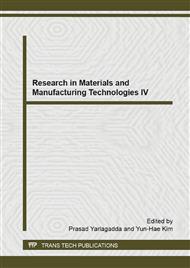p.324
p.328
p.333
p.337
p.342
p.351
p.355
p.359
p.371
Determination of Experimental Conditions of Preparation of Zeolites from Fly Ashes via Alkaline Fusion Followed by Hydrothermal Crystallization
Abstract:
In this study, we converted high silicon fly ashes (FA) to zeolites using a two stages conversion process: alkaline fusion followed by hydrothermal crystallization. The orthogonal experimental method was applied to design the experimental variables of alkaline fusing and hydrothermal crystallizing procedure. Alkaline fusion prior to hydrothermal synthesis was applied to collapse the FA crystalline phases and release Si content. Different from most of the research, the mixtures of NaOH and Na2CO3 were used to increase the fusion temperature in order to remove the residue carbon simultaneously. Acid solubility was used to evaluate the efficiency of alkaline fusion. Then the optimized alkali-fused FA was resolved in the NaOH solutions and the experiment conditions were designed by the orthogonal experimental method. XRD and SEM were employed to characterize the crystalline phases and microimages of the raw FA and the treated FA. Adsorption process of methylene blue was applied to simulate the adsorption ability of the fly ash zeolites. Finally, the optimized conditions of alkaline fusion and hydrothermal treatment were concluded.
Info:
Periodical:
Pages:
342-350
Citation:
Online since:
December 2014
Authors:
Keywords:
Price:
Сopyright:
© 2015 Trans Tech Publications Ltd. All Rights Reserved
Share:
Citation:


